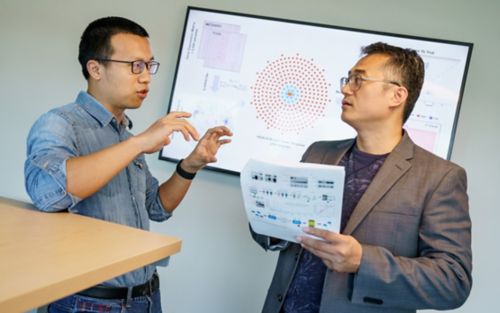St. Jude Family of Websites
Explore our cutting edge research, world-class patient care, career opportunities and more.
St. Jude Children's Research Hospital Home

- Fundraising
St. Jude Family of Websites
Explore our cutting edge research, world-class patient care, career opportunities and more.
St. Jude Children's Research Hospital Home

- Fundraising
Math test points metastatic breast cancer treatment in the right direction

First author Qingfei Pan, PhD, and corresponding author Jiyang Yu, PhD, Computational Biology, of a new Nature Cancer paper detailing a math test for cancers.
What if we could give cancer a math test – and treat tumors more effectively based on how they score?
Jiyang Yu, PhD, St. Jude Department of Computational Biology, has spent his career creating and improving such a test for metastatic breast cancer. His work demonstrated that cancer cells with the highest test score are more sensitive to a novel drug combination. Promising findings from a phase Ib clinical trial that used the score to guide treatment were published recently in Nature Cancer.
“We showed that computational biology can make a difference to cancer treatment,” said Yu, a co-corresponding author of the study. “We were able to identify a novel drug therapy combination that would work well for patients with certain metastatic cancers. This is important because these types of cancers often have a poor prognosis with standard therapies. This kind of computational score can be used for novel cancer therapy development.”
Yu started his career showing that treatment for certain cancers—metastatic breast cancer in particular—can be guided by a computational score obtained in the lab. He then improved this ‘math test’ over the years until it worked well enough to justify a clinical trial. The decade-long quest provides a behind-the-scenes look at breast cancer research, the capabilities of computational biology and the power of perseverance.
Looking beyond genetics in cancer treatment
Outcomes for patients with metastatic breast cancer remain poor. One reason is the lack of effective treatments. Most targeted drugs are based on designed against specific genetic alterations. But only a small number of patients with cancer have mutations that are targetable and even for those who do, less than half respond to those drugs.
“Unfortunately, the mutation-based biomarkers for precision medicine explain less than 30% of cancers,” Yu said. “Therefore, over half of cancer patients don't harbor druggable or targeted mutations in DNA. So, we looked for the drug sensitivity biomarkers that are non-genetic.”
Yu got the idea to develop a score to better guide treatment for metastatic breast cancer while in graduate school. He realized saving patients’ lives requires scientists and physicians to look beyond DNA to find vulnerabilities in cancer that can be drugged.
A promising PhD student’s discovery
As a graduate student in the laboratory of Andrea Califano, PhD, at Columbia University, Yu created the first version of the math test specific to breast cancer. He used technologies including microarray and RNA-seq to look at the genes expressed in breast cancer samples sensitive to a specific drug. Microarray and RNA-seq are techniques that measure RNA instead of DNA in the cell. By looking at the RNA, scientists can learn what genes are expressed and at what intensity.
“Inflammatory breast cancer [IBC] is the most lethal form of breast cancer with a 5-year survival rate of only 40%,” Yu said. “IBC is highly metastatic. Once the tumor develops metastasis, they’re generally resistant to all kinds of therapies, including conventional chemotherapy or targeted therapies.”
To address the low survival rate of IBC, Yu teamed up with Jose M. Silva, PhD, a breast cancer biologist and pathologist at Columbia University, to search for novel drug targets by looking at RNA. They found HDAC6 was a promising therapeutic target for IBC.
Yu discovered the potential of HDAC6 using a network-based approach to analyze RNA expression data of IBC and non-IBC samples. He used RNAi screening, a technique that knocks-down gene expression in a high-throughput fashion and was commonly used before CRISPR was developed. With this technique, Yu found HDAC6 was necessary for IBC cells to stay alive. The initial identification of HDAC6 as a potential targetable dependency in IBC was published by Yu and colleagues in Breast Cancer Research in 2015.
Math meets clinical trial
Yu created a computational score that used RNA expression data to predict HDAC6 activity and tumor sensitivity to HDAC6 inhibitors. The score integrated the data of the 140 RNA transcripts from each breast cancer sample. The higher the score, the more sensitive the cancer was to the drug. His focus was the drug Ricolinostat, which targeted the protein HDAC6.
Histone deacetylases (HDACs) chemically modify the proteins that spool DNA and allow its organized compaction into cells. HDACs control DNA accessibility to the proteins that make RNA transcripts from the DNA templates. HDACs often have abnormal activity in cancer that is necessary to maintain uncontrolled growth. However, simultaneously inhibiting all the enzymes in the HDAC family in cells is highly toxic, so the approach can’t be used in humans. Ricolinostat is a more promising approach because it only targets HDAC6 and, when used in combination with standard breast cancer chemotherapy, kills cancer cells in the lab.
“IBC is rare, so it is almost impossible to initiate an IBC-focused clinical trial,” Yu said. “Instead, we applied the score to a large breast cancer cohort and found that other subsets of breast cancer may also have a high HDAC6 score, such as 60% of hormone receptor positive breast cancer, the most common breast cancer subtype.”
Broader applicability of the score and targeted HDAC6 therapy led to a Phase I clinical trial in metastatic breast cancer led by Kevin Kalinsky, MD, a molecular oncologist at Columbia University.
New phases in his research and career
Yu joined Pfizer after completing his PhD but kept in contact with his collaborators, Silva and Kalinsky, who are also co-corresponding authors of the new Nature Cancer paper. They continued the project. Yu rejoined the effort a few years later once he was a faculty member at St. Jude and had his own laboratory.
Yu assigned one of his lab’s postdoctoral scientists to improve the HDAC6 score’s ability to predict drug sensitivity. Yu had created the original version almost seven years earlier, so computing power, data analysis, sampling methods and available data sets had exponential increases in capabilities. He believed these technological breakthroughs could be leveraged to create better sensitivity scores.
Qingfei Pan, PhD, a former postdoctoral fellow and current bioinformatics research scientist in the Yu lab, accepted the challenge and made the HDAC6 score more robust.
“First we involved more data from cancer patients’ tumors,” Pan said. “We used over 3,000 samples, collected from the two biggest breast cancer patient cohorts, The Cancer Genome Atlas (TCGA) and the Molecular Taxonomy of Breast Cancer International Consortium (METABRIC).” By including more samples from TCGA and METABRIC, Pan was able to expand the scientists’ understanding of the RNA transcript set related to HDAC6 functions that are important in breast cancer.
The RNA transcripts related to HDAC6 were termed the HDAC6 regulon. Yu’s version included about 140 transcripts. Pan’s next-generation score incorporated the data from approximately 300 transcripts.
“The second improvement was our ability to see more subtypes of breast cancers to make a more robust model,” Pan said. “These two changes made the next generation of HDAC6 regulon.”
Armed with the new method for creating the score, Yu connected with his original collaborators for a clinical trial. A phase I clinical trial was designed to test the drug combination’s safety, using Ricolinostat and the standard-of-care chemotherapy. But it also produced preliminary results seemingly indicating that the score predicted positive responses.
A Myc-based mechanism
After the trial, Yu’s group found the molecular mechanism that explained why inhibiting HDAC6 had an anti-cancer effect – it relationship to the protein c-Myc.
C-Myc is involved in many cancers. Its normal function is to be a proliferation signal, telling a cell to multiply. Therefore, many cancers alter c-Myc function. The St. Jude researchers and Silva, who moved from Columbia University to Mount Sinai, found that HDAC6 directly deacetylated the protein c-Myc. Deacetylation is a chemical modification that affects protein function. They found the particular place on the c-Myc protein that was modified.
The deacetylation of c-Myc by HDAC6 leads to c-Myc accumulation. In essence, HDAC6 is removing the brakes from cell proliferation in certain cancer types. Thus, the cancer cells are free to “step on the gas” and multiply out of control. Then they showed that HDAC6 inhibition with Ricolinostat reduced c-Myc activity. The HDAC6 inhibitor acts as a brake on uncontrolled cell growth by indirectly leading to c-Myc degradation.
Given the centrality of c-Myc in many cancers, Yu reasoned that the HDAC6 score might apply to other malignancies. Yu and his colleagues showed that multiple myeloma, leukemia and lymphoma, along with subsets of prostate, colorectal, brain, and other cancers also exhibited high HDAC6 scores, suggesting potential sensitivity to Ricolinostat.
“We went beyond breast cancer to other types of cancers and showed that HDAC6 might be a non-genetic ‘hidden’ driver in many other cancer types,” Yu said. “The HDAC6 score is also predictive, especially when you use it in the cancer type specific tests. “The score can work even better than the breast cancer-specific HDAC6 score. So this could also be used as a biomarker in a cancer type-specific, or context-specific, manner.”
A tale of promise for computational biology
Success of the phase I trial for the HDAC6 score highlights that computational biology can be integrated into improving patient care. It just requires the right team of collaborators and persistence on the part of investigators to push the project forward.
“Translational research takes a village,” Yu said. “It's not just one scientist or one lab. It requires collaboration from a team of talented scientists and clinicians. Especially with the exponentially increasing amount of data, the research work extends far beyond the scope of only performing data analysis within computational biology. We can really translate computational predictions, with the right collaborators, into actionable knowledge to benefit cancer therapeutics and patient care.”






